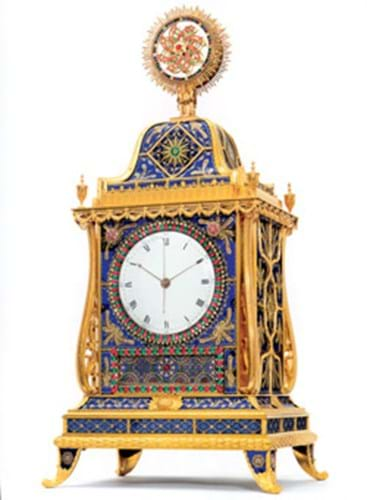
The glitzy upmarket version of a musical automated fantasy timekeeper beat the previous record of $1.9m (£1.17m) set by Thomas Tompion's repeating table clock which sold at Sotheby's New York in 1999.
Cased in ormolu, applied with blue guilloche enamel and studded with paste gems, it measured 2ft 5in (74cm) high.
Borrell's was one of a collection of 15 similar musical automaton clocks created in the late 18th century for the Chinese market, either by European clock makers or by Chinese craftsmen imitating the European style from their workshops in Guangzhou province.
These and other distinctive decorative touches such as revolving Catherine wheels, twisted glass rods that turn to imitate falling water, and gem-set tiered trees and parades of figures, are common features of these expensive horological toys created for prestigious customers.
The European examples were almost always intended as diplomatic gifts, most often for the Imperial Court. Borrell's clock is the pair to a version reputedly made for Lord Macartney to present to the Qianlong Emperor in 1793.
All 15 clocks had been assembled by Kaichiro Nezu for the private museum that he founded in 1940 and are the largest body of such Chinese market clocks outside the Palace Museum Beijing. They were offered for sale at Christie's by his son Koichi Nezu, the current chairman and director because, while an important group, they lie outside the museum's main collecting focus of Japanese art.
When a selection of the Nezu clocks were put on display in London earlier this year, they made a dazzling visual and aural spectacle as they chimed and whirred their way through their paces.
Christie's created a similar display for their Hong Kong Convention and Exhibition Centre view and were inundated with visitors coming to see what Christie's departmental head Jamie Collingridge described as "the finest working display of musical and automaton clocks since James Cox closed his famous London Museum over 200 years ago".
But the enthusiasm for this dispersal came from bidders from China, Taiwan, Hong Kong, the Americas, Russia, the Middle East and Europe, producing enough demand to ensure that every one of the 15 examples was pursued to estimate-crushing levels.
When the pair to Borrell's clock last came up for sale in London in 2001 it realised £200,000, only a fraction of the sum paid out last week.
The final outcome was a hammer total of HK$246.5m (£16.65m), which Christie's reckon to be the highest ever recorded for a horological auction. And even Borrell's English record-breaker was not the highest price.
That was surpassed when a European private buyer took a Guangzhou workshops Imperial Qianlong period clock to HK$35m (£2.36m), a record for a Chinese clock. The Chinese-adapted English movement of this clock is set in the central tier of a three-stage case over an automaton base and below an enamelled jardinière of gem-set flowers.
The Nezu Museum collection was a single-owner exotic step outside the traditional fare for this six-day Hong Kong series. The other sales comprised Chinese ceramics and works of art, traditional modern and contemporary Asian paintings, jewels and watches.
Further records for individual lots and overall sales took the entire series to a HK$2.4bn (£162m) total including buyer's premium.
By Anne Crane




